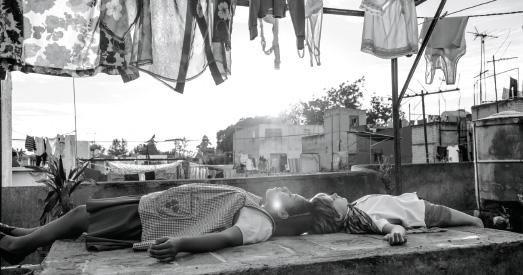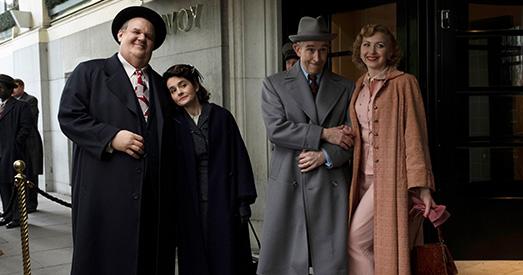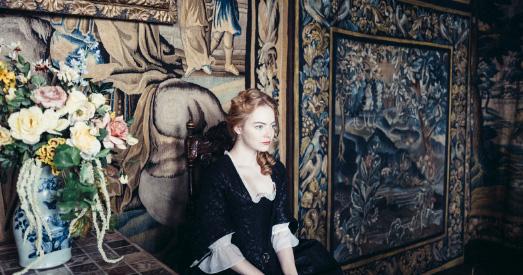The American Film Institute’s annual film festival, which took place Nov. 8-15, is arguably Los Angeles’ best and most comprehensive annual fete of feature, documentary, short, animated, domestic and foreign cinema. Here are capsule reviews of some of AFI Fest 2018’s myriad productions.
THE WEEKEND -
Woody Allen’s films have sometimes been criticized for their dearth of Black characters, even if most of the Manhattanite’s movies have been set and shot in New York City. This despite the fact that according to the 2006-2008 U.S. Census 25.1% of NYC’s 8.5 million residents are Black - somehow the Woodman consistently managed to miss the estimated 2,086,566 Black people residing in New York City. Toronto-born writer/director Stella Meghie may not be American, but she is of African ancestry and her new rom-com, The Weekend, is a sort of all-Black Woody Allen type of comedy.
However, that being said, The Weekend takes place mostly in rural California, apparently near the town of Agua Dulce, which is located north of the City of Los Angeles in L.A. County and where less than 2% of the population is Black, according to the 2010 U.S. Census. Nevertheless, stand-up comic Zadie’s (Sasheer Zamata, who was a minor - token? - cast member on SNL, 2014-2017) mother (sitcom veteran Kym Whitley) owns a bed and breakfast located in California’s countryside, where Zadie goes to spend the eponymous weekend.
Rather strangely, and stretching credulity, the single and relationship-challenged zany Zadie does so with her ex Bradford (Tone Bell), who she still hasn’t gotten over, and rather improbably along with his new girlfriend Margo (DeWanda Wise, who plays Nola Darling in the Netflix version of Spike Lee’s She’s Gotta Have It). The plot becomes Woody-esque when Aubrey (Y'lan Noel of HBO’s Insecure, which gratuitously uses the “N” word more promiscuously than a Klan rally) checks in at the B & B for the weekend. Like in Allen’s movies, the comic implications of relationship fluidity and shifting sexual/romantic pairings becomes the basis of the plot. Who will - or won’t - sleep with who? Inquiring minds want to know.
The Weekend, which was screened during AFI Fest at the TCL Chinese 6 Theatres on Hollywood Blvd., is mildly amusing. Although he’s handsome, personality-wise Bradford is a huge drip as a character, and it’s hard to see what zippy Zadie, who is a firecracker, ever saw in this bore, and worse, why she wasted three years pining after him when Bradford broke up with the too-hot-to-handle comedienne? There is a stupid scene where Zadie is in bed with a male partner and refers to herself as being naked, when she is actually wearing a shirt and shorts. Listen filmmakers, if you are too cowardly to use the constitutional right to depict nudity onscreen - an anti-censorship right artists fought for for decades - then simply do NOT include these scenes. Who are we supposed to believe? Our ears, when Zadie refers to herself as being nude, or our lying eyes when we can clearly see she’s clothed? Truly stupid puritanical nonsense. (Then again, the off-kilter Zadie has a wacky fashion sense - after expropriating a fancy dress from her mother’s wardrobe she wears a T-shirt beneath it. What a fashion nerd - but perhaps that’s meant to be part of her charm?)
Despite its implausible premise and some irrational behavior, I found the 86 minute The Weekend’s denouement to be satisfying and real. Black audiences may be delighted to watch a rom-com featuring characters who look like them and are petit-bourgeois professionals, as opposed to being stereotypical lumpenized thugs, hoods and hos. Non-Black theatergoers are likely to find The Weekend to be reasonably entertaining fare for a weekend outing to the picture show.
ROMA -
I don’t understand why Mexican auteur Alfonso Cuarón’s (2001’s Y Tu Mama Tambien) new semi-autobiographical film is called Roma, because it is set in Mexico City, not Rome, and it isn’t about the people that have also been called “Gypsies.” But be that as it may, this 2 hour, 15 minute black and white feature shot in widescreen is not so much about Cuaron, but about his petit-bourgeois family’s live-in maid, Cleo (Yalitza Aparicio). She is a young indigenous woman from the countryside (at one point we hear that the government is taking her mother’s land away from her), devoted to caring for Cuaron’s fair skinned family and their household.
The film slowly, deliberately unfolds with what seems to be mundane details. Roma is a bit Fellini-esque - that Italian genius even co-wrote/directed a 1972 feature also named Roma. But the Fellini film Cuaron’s ode to his childhood memories most reminds me of is Federico’s charming 1973 Amarcord, which translates as “I Remember.” Having said that, for the most part Cuaron’s Roma doesn’t have characters as outrageous as the Fellini-esque inhabitants of the maestro’s movies.
Fermín (superbly crafted by newcomer Jorge Antonio Guerrero) is an exception. His actions in the few scenes he appears in delineate and hone in on his character as a complete cad, who Cleo - perhaps starving and yearning for romance - makes the mistake of getting involved with. The superhero-like Professor Zovek, appropriately played by a professional wrestler whose ring name (and the one used in the credits) is “Latin Lover,” is another madcap Fellini-esque character.
As Cleo, Aparicio plays the dark-skinned domestic in a Neo-Realist manner, as someone with both feet firmly on the ground. Roma is a story that gains mounting momentum and has a cumulative effect. Cleo is swept up in a student demonstration with cataclysmic effects that your plot spoiler adverse reviewer won’t divulge. But it is absolutely one of the most heart wrenching sequences viewers are likely to see onscreen nowadays. Later, the diminutive Cleo, who doesn’t know how to swim, is faced with a do or die situation at a beach with pounding waves.
Roma was screened inside of the Chinese 1, the largest theatre at the TCL Chinese 6 Theatres on Hollywood Blvd., and it was completely sold out. Cuaron’s beautiful homage to the servant who helped raise him won the Golden Lion for Best Film at the Venice Film Festival, while Cuaron himself won Venice’s SIGNIS Award. I imagine the Spanish language Roma with English subtitles is a strong contender for the Best Foreign Film Oscar, while Aparicio deserves a Best Acting Academy Award. Since the heyday of Italian Neo-Realism, Roma is one of the best films ever made outside of the socialist world about a humble domestic, full of simple heroism, humanity and dignity, with an indigenous female in the lead role.
Aparicio’s beautifully drawn character may just be a salt of the Earth, modest maid, but man - this Cleo is a Cleopatra.
Roma theatrically opens Nov. 21 and it will be streamed on Netflix starting Dec. 14.
THE FAVOURITE -
The Favourite is set in the court of Queen Anne (Olivia Colman) during the early 18th century when England and Scotland joined together to become Great Britain - which is ironic as Britain’s 2018 female head of government is now negotiating Brexit, in order to remove the U.K. from the European Union. In any case, other historical figures in this stylishly shot period piece helmed by Greek-born Yorgos Lanthimos (2015’s surreal The Lobster) - who introduced the AFI Fest screening at The Egyptian Theatre - include Lady Sarah (London-born Rachel Weisz, Best Actress Oscar winner for 2005’s The Constant Gardener) and Abigail (Emma Stone, 2016’s La La Land).
Considering that The Favourite is about powerful women wielding state control it’s interesting that this 2 hour feature is being released just as a record number of women have been elected to the U.S. House of Representatives and as the #MeToo movement empowers the sisterhood. There is also so much palace intrigue taking place onscreen, with various power players jockeying for position that it seems to symbolize the Trump White House. With members of parliament vying with aristocrats it is also redolent of the looming clash between the post- “Blue Wave” House of Representatives and the Oval Office.
The Favourite of course deals with sexual politics and dynamics and there is a lesbian subtext. Class, too, plays a major role. My take away was that when it comes to the power elite, it is not mainly a question of gender but of the nature of domination, who holds sway in the pecking order to reign over and rule others. Pigs are pigs, no matter what their genitalia.
I’d never heard of any of these parliamentarians, courtiers, royals, etc., and was surprised after the screening when I was researching my review to learn that this saga about the crown, privilege, entitlement, etc., was actually inspired by real life people. Watching this well-acted, well-lit, well-shot (with convex lenses by director of photography Robbie Ryan) movie may transport you 300 years into the past as it brings alive 1700. The Favourite will be theatrically released Nov. 23.
STAN & OLLIE -
First of all, this 97 minute period biopic about Laurel and Hardy is peerlessly acted by Steve Coogan and John C. Reilly, who is especially outstanding immersed in a fat suit, makeup and prosthetics by Mark Coulier and team, to make him look like Oliver Hardy. As a film historian I relished the opportunity to see a biopic about one of the silver screen’s most dynamic comedy duos. But alas, there is scant footage depicting their Hollywood heyday, as Laurel and Hardy act on a 1937 set and clash with Hal Roach (Danny Huston, a canny choice to depict a figure from Tinseltown’s Golden Age, given his pedigree as the son and grandson of John and Walter Huston), who is portrayed as an exploitative producer squeezing profits out of his players. At issue and at stake is the notion of creative control, which Stan is willing to fight for while Ollie is more conciliatory.
Most of this partial biopic takes place 16 years later, when Stan and Ollie are washed up in pictures and embark on a grueling tour of playhouses and various venues in Britain, where Stan Laurel hailed from (Oliver Hardy was actually from Georgia). The film focuses on the team’s personal dynamics and we see a number of their film and Vaudeville routines reenacted, which of course is good fun.
Jon Baird’s direction is right on the nose and this is basically a very conventional narrative film. Jeff Pope (who wrote 2013’s Philomena also co-starring Coogan) misses the mark in this biopic that largely ignores Laurel and Hardy’s screen work. Although I personally enjoyed Stan & Ollie, I’m a film historian and critic - this is mainly a movie for Laurel and Hardy buffs, comedy and film fans and the like. But if one’s not interested in these subjects you’re likely to agree with Ollie: “That’s another fine mess you’ve gotten me into.”
In any case, it was great seeing Reilly, Coogan, other members of the cast and crew and descendants of Stan at the AFI screening at the Egyptian (an ideal venue for a film such as this). But movie buffs are, to paraphrase Mel Brooks, likely to want to extend a hardy handshake and laurels to the filmmakers and relatives.
Stan & Ollie opens Dec. 28.
For more info: http://www.afi.com/afifest/.
The third edition of “The Hawaii Movie and Television Book”, co-authored by L.A.-based film historian/reviewer Ed Rampell, is available at: https://mutualpublishing.com/product/the-hawaii-movie-and-television-book/.



